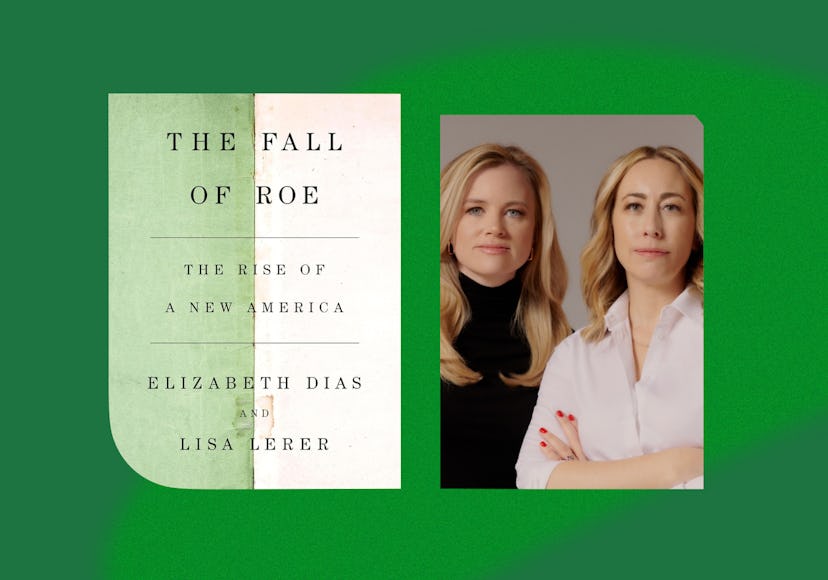Q&A
It's Been Two Years Since Roe v. Wade Fell. What Next?
A new book explores how America got here.

The moment Roe v. Wade fell on June 24, 2022, a woman at an anti-abortion clinic in Ohio was on the ultrasound table, viewing her 20-week-old fetus. Outside, another woman was celebrating the center’s staff who had encouraged her to keep her pregnancy and give birth nine years earlier as a teenager. Amid it all, reporters Elizabeth Dias and Lisa Lerer were taking notes.
The result is The Fall of Roe: The Rise of a New America, out today. The pair met in 2018 when they joined The New York Times to cover religion and politics, respectively. Both frequently write about abortion; their partnership was cemented in 2019 on a reporting road trip through the South.
They were texting and calling each other on Dec. 1, 2021 as they listened to the oral arguments for Dobbs v. Jackson Women’s Health Organization, the Supreme Court case that overturned the federal right to abortion established by Roe v. Wade in 1973.
“We were watching this unfold in real time,” Dias says. “Afterwards, I remember a little silence on the call, like, ‘OK, are we going to have to do this?’”
They set out to write a nonpartisan narrative chronicling the past decade’s political chess game, exploring how former President Barack Obama’s 2012 win motivated an elite network of Christian lawyers and powerbrokers to decimate reproductive rights. They also spoke to a range of people about their own abortions, from former Planned Parenthood President Cecile Richards to the woman who received the final abortion in South Dakota’s last open clinic.
“There’s no way to tell this big political story without really getting into the personal,” Lerer says.
Below, the co-authors discuss why Roe toppled, the current state of abortion access, and which issues could be on the chopping block next.
Why did you want to write this book?
Elizabeth Dias: We wanted to figure out what got the country to this point. Why was it that so many people didn’t believe that Roe could be overturned?
Lisa Lerer: One thing that was really important to us was making this story deeply accessible. It was written for people who wouldn’t necessarily pick up a Bob Woodward book on Trump. We’ve both been in a lot of book clubs, and generally, it’s like, “OK, this is our one [non-fiction pick], and now we’re back to all our novels.” We joke, let us be your one book.
Why did you choose to start this narrative in 2012?
LL: When former President Obama was reelected, so many leaders of the anti-abortion movement felt lost, like the Republican Party had abandoned them. This group, especially of conservative Christian women, determined they were going to fight back. So we started with what they described as their lowest point.
How does religion play a role?
LL: This story takes place in the bigger arc of the conflict between religion and rising secularism in America. It actually has deep roots in how, frankly, Christianity is based in many ways on the Virgin Mary giving birth when she was quite young. The divine element of pregnancy is such a core part of how [the anti-abortion movement] thinks about this.
What did the reporting process look like?
ED: We spent time on the ground up close with women in four places during that last month [before Roe fell].
LL: We were outside the clinic that was at the center of the Dobbs case with some of the women who have spent years defending it as clinic escorts supporting patients. When they were shut down, we relocated to New Mexico with them.
ED: We decided it was also really important to know the personal stories of the characters who were instrumental in both overturning Roe and in fighting to preserve abortion rights — like Cecile Richards of Planned Parenthood and Ilyse Hogue of NARAL Pro-Choice America on the left, and on the right, Marjorie Dannenfelser of Susan B. Anthony of Pro-Life America. We listened to their own stories about pregnancy, fertility, and abortion, in some cases, to understand the factors that shaped them in their fight.
What is the state of abortion access in 2024?
LL: The number actually went up, and that’s due to an increase in medication abortion ([nearly] two-thirds of abortions in the U.S. happen with medication). There are efforts to curb, if not eliminate, access to the most popular type of medication, and the Supreme Court is going to issue a decision on that this term.
What’s next for the fight over abortion rights?
LL: People should keep their eye on the Comstock Act, which is the Civil War-era law criminalizing the mailing of lewd material. There’s been some talk around people close to former President Trump that [Republicans] might want to start enforcing the Comstock Act again. Depending on how it’s interpreted, it could potentially be used to functionally ban all abortion in the country.
In his opinion on Dobbs, Justice Clarence Thomas wrote that the Supreme Court “should reconsider” rights regarding contraception access, same-sex relationships, and same-sex marriage. What does the recent history of abortion in this country teach us about facing these other issues?
LL: Republicans have been really explicit that they don’t want to target birth control contraception, but there’s definitely a sense of concern about what could happen in the future. (Editor’s note: A 2022 FiveThirtyEight/Ipsos poll found that 93% of Republicans support birth control pills in “all or most cases.”) With these efforts to overturn abortion, people on the left sort of dismissed it as all talk, right? So, one lesson is to listen to people when they tell you what they want to do. Nothing is permanent. Even 50-year-old precedents can go.
ED: A lot can be happening when you’re focused on something else.
This interview has been edited and condensed for clarity.